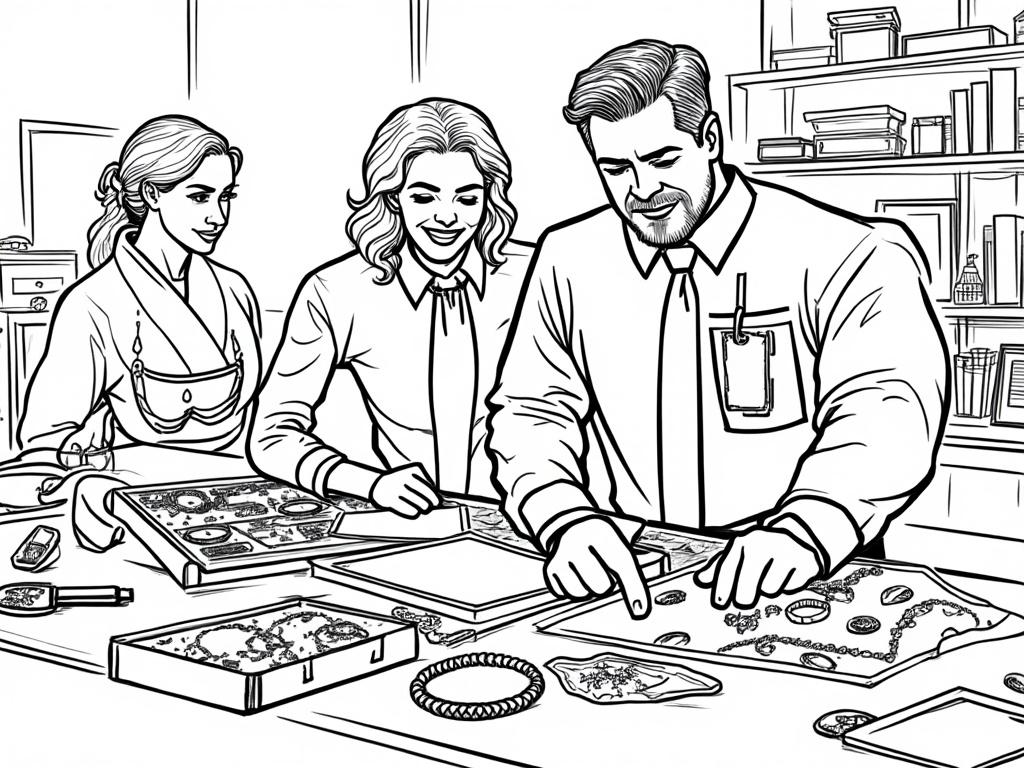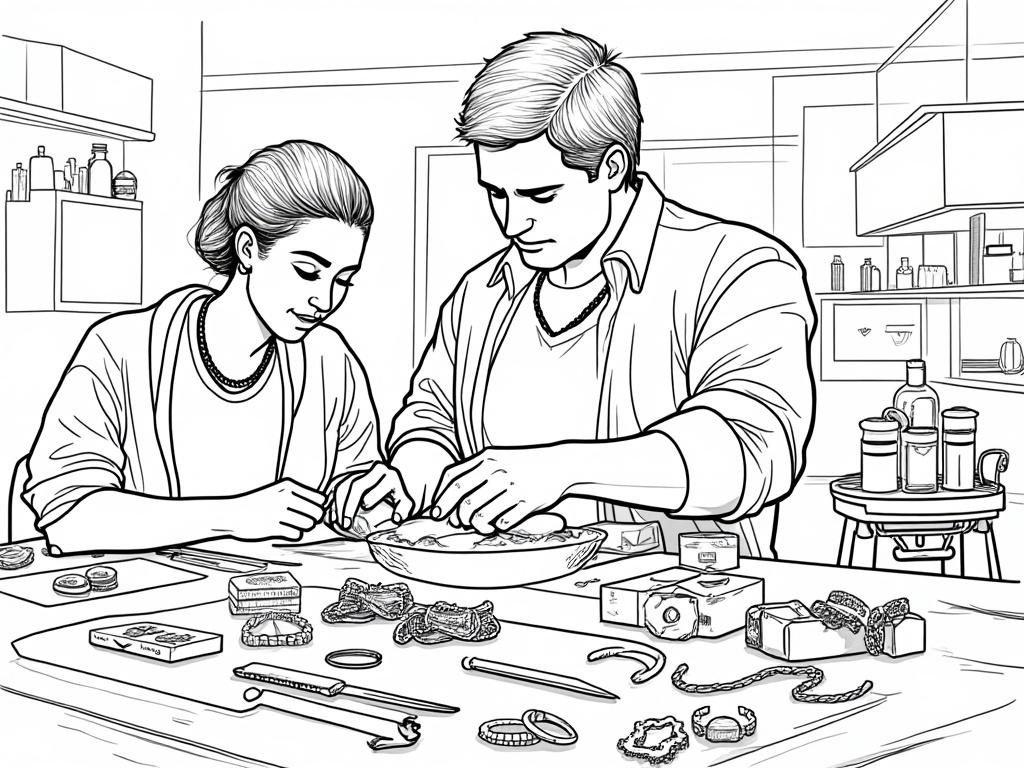
How to Start a Gold Jewelry Business: From Concept to Cash Flow
Reading time: 12 minutes
Table of Contents
- Understanding Your Golden Opportunity
- Market Research That Actually Matters
- Legal Framework and Compliance
- Strategic Sourcing and Supplier Relations
- Design Philosophy and Product Development
- Workshop Setup and Operational Excellence
- Marketing Strategies That Convert
- Sales Channels and Customer Acquisition
- Brand Building for Long-term Success
- Your Golden Blueprint: Next Steps
- Essential Questions Answered
Understanding Your Golden Opportunity
Ever wondered why gold jewelry remains one of the most resilient business sectors? Here’s the straight talk: While fashion trends come and go, gold represents timeless value, emotional significance, and cultural heritage rolled into one profitable package.
The global jewelry market reached $348.5 billion in 2022, with gold jewelry commanding approximately 70% of this market share. But here’s what most aspiring entrepreneurs miss—success isn’t just about beautiful designs or premium materials. It’s about understanding the intricate dance between craftsmanship, market positioning, and customer psychology.
Quick Reality Check: Starting a gold jewelry business isn’t like opening a regular retail store. You’re dealing with precious metals, fluctuating gold prices, regulatory compliance, and customers making emotionally-charged purchases. The barriers to entry are real, but so are the rewards for those who navigate them strategically.
Market Research That Actually Matters
Before you sketch your first design or source your first gram of gold, you need to decode your market with surgical precision. Generic market research won’t cut it—you need insights that translate directly into profitable decisions.
Identifying Your Profitable Niche
The jewelry market isn’t monolithic. Consider these distinct segments:
- Bridal Jewelry: High-value, emotional purchases with seasonal spikes
- Fashion Jewelry: Trend-driven, faster turnover, lower price points
- Investment Pieces: Focus on gold purity and weight
- Custom Commissions: Personalized, premium pricing opportunities
Case Study: Sarah Martinez started “Ethereal Gold” in Austin, Texas, focusing exclusively on minimalist gold jewelry for millennial professionals. By targeting women aged 25-35 earning $50,000+, she achieved $400,000 in first-year revenue by understanding her niche’s preference for versatile, office-to-evening pieces priced between $150-$500.
Competitive Analysis Framework
Market Positioning Analysis
Data represents market penetration and competitive density across different jewelry business models
Legal Framework and Compliance
Navigating jewelry business regulations isn’t just about avoiding fines—it’s about building trust that translates into premium pricing and customer loyalty. Here’s what you absolutely need to know:
Essential Licensing and Permits
Federal Requirements:
- Employer Identification Number (EIN): Required for tax purposes and business banking
- Precious Metals Dealer License: Varies by state, mandatory for gold purchasing/selling
- Sales Tax Permit: Essential for retail operations
Pro Tip: Many states require precious metals dealers to hold inventory for specific waiting periods and maintain detailed transaction records. In California, for instance, you must hold purchased gold for 30 days before resale.
Quality Standards and Hallmarking
Gold purity standards aren’t just technical specifications—they’re your credibility markers. Understanding karat systems, testing methods, and certification processes protects both your business and customers.
| Gold Purity | Karat Rating | Typical Use | Price Premium | Durability |
|---|---|---|---|---|
| 99.9% | 24K | Investment pieces | Highest | Soft, easily damaged |
| 75.0% | 18K | Fine jewelry | Premium | Good balance |
| 58.3% | 14K | Everyday wear | Moderate | Excellent durability |
| 41.7% | 10K | Budget-friendly | Entry-level | Maximum durability |
Strategic Sourcing and Supplier Relations
Your supplier relationships will make or break your margins. The difference between a thriving jewelry business and one that struggles often comes down to sourcing strategy.
Building Reliable Supply Chains
Primary Sourcing Options:
- Refineries: Direct access, wholesale pricing, minimum order requirements
- Bullion Dealers: Flexible quantities, market-rate pricing
- Jewelry Supply Companies: Prepared alloys, additional materials, higher costs
- Recycled Gold Sources: Cost-effective, environmental benefits, quality considerations
Real-World Example: Denver-based “Mountain Gold Designs” reduced material costs by 15% by establishing relationships with three regional recycling centers, ensuring steady supply of recycled gold while appealing to environmentally-conscious customers.
Managing Price Volatility
Gold prices fluctuate daily. Smart jewelry entrepreneurs hedge against volatility through strategic purchasing and pricing models. Consider implementing a “spot price plus” system where your pricing adjusts with market conditions, protecting margins while remaining competitive.
Design Philosophy and Product Development
Great jewelry design isn’t just about aesthetics—it’s about creating pieces that solve problems, evoke emotions, and justify premium pricing. Your design philosophy becomes your competitive moat.
Developing Your Signature Style
Successful jewelry brands have recognizable design DNA. Whether it’s Pandora’s charm system or Tiffany’s distinctive blue box aesthetic, your signature style should be:
- Distinctive: Recognizable across your product line
- Scalable: Adaptable to different price points
- Manufacturable: Feasible with your production capabilities
- Market-Aligned: Resonant with your target demographic
Technical Considerations
Design isn’t just artistic expression—it’s engineering. Consider wearability, durability, and manufacturing complexity. A beautiful design that’s uncomfortable to wear or expensive to produce won’t build a sustainable business.
Key Design Principles:
- Balance visual appeal with structural integrity
- Consider skin sensitivity and hypoallergenic requirements
- Design for your manufacturing capabilities and skill level
- Factor in gold weight for accurate pricing
Workshop Setup and Operational Excellence
Your workshop is where creativity meets commerce. The right setup balances efficiency, safety, and scalability while staying within budget constraints.
Essential Equipment Investment
Startup Equipment Priorities:
- Safety First: Ventilation system, fire extinguisher, eye protection ($500-$1,500)
- Basic Tools: Jeweler’s saw, files, pliers, hammers ($200-$500)
- Soldering Setup: Torch, flux, solder, heat-resistant surface ($300-$800)
- Finishing Equipment: Polishing motor, compounds, tumbler ($400-$1,200)
- Precision Tools: Digital scale, calipers, magnification ($150-$400)
Budget Reality: A functional startup workshop requires $2,000-$5,000 in initial equipment. Don’t let perfectionist tendencies drain your capital—start with essentials and upgrade as revenue grows.
Quality Control Systems
Consistency builds reputation. Develop standardized processes for testing gold purity, checking dimensions, and finishing quality. Document everything—your future self will thank you when training employees or troubleshooting issues.
Marketing Strategies That Convert
Marketing jewelry isn’t like marketing software or consulting services. You’re selling beauty, status, emotion, and personal expression. Your marketing must reflect these intangible values while driving concrete sales.
Digital Marketing Essentials
Platform-Specific Strategies:
- Instagram: Visual storytelling, behind-the-scenes content, influencer partnerships
- Pinterest: Bridal boards, style inspiration, seasonal collections
- Facebook: Customer testimonials, live crafting sessions, local community engagement
- Google Ads: Target high-intent keywords like “custom engagement rings” or “gold necklace gift”
Content That Converts: Focus on transformation stories. Show how your jewelry enhances special moments, celebrates achievements, or expresses personal style. Emotional connection drives jewelry purchases more than technical specifications.
Pricing Psychology
Jewelry pricing involves complex psychology. Customers expect to pay premium prices for gold jewelry—pricing too low can actually hurt sales by suggesting inferior quality. Use psychological pricing ($199 vs. $200), bundle options, and clear value propositions.
Sales Channels and Customer Acquisition
Diversified sales channels protect against market fluctuations and maximize revenue opportunities. Each channel serves different customer segments and purchase behaviors.
Omnichannel Strategy
Channel Performance Comparison:
- Online Direct-to-Consumer: Highest margins, global reach, 24/7 sales
- Craft Shows/Markets: Personal interaction, immediate feedback, seasonal revenue
- Retail Partnerships: Expanded distribution, shared marketing costs, lower margins
- Custom Commissions: Premium pricing, unique pieces, relationship-based sales
Case Study: “Luna Gold Studio” in Portland achieved $200,000 annual revenue by combining online sales (60%), local craft shows (25%), and custom commissions (15%). This diversification provided stability during COVID-19 when craft shows were cancelled.
Brand Building for Long-term Success
Your brand is your business’s most valuable asset—more valuable than inventory, equipment, or even customer lists. Strong brands command premium pricing, generate customer loyalty, and create barriers to competition.
Brand Identity Development
Effective jewelry branding transcends logos and color schemes. It encompasses your story, values, customer experience, and emotional positioning. Ask yourself: What feeling do customers get when they think about your brand?
Brand Positioning Framework:
- Heritage vs. Innovation: Traditional craftsmanship or cutting-edge design?
- Accessible vs. Exclusive: Everyday luxury or special occasion pieces?
- Personal vs. Professional: Individual expression or corporate gifting?
Customer Experience Excellence
Jewelry purchases are highly personal and often emotional. Every customer touchpoint—from initial discovery to post-purchase care—shapes perception and drives referrals. Exceptional customer experience becomes your competitive advantage in a crowded market.
Your Golden Blueprint: Next Steps
Ready to transform your jewelry dreams into profitable reality? Here’s your strategic roadmap for the next 90 days:
Immediate Actions (Week 1-2):
- Complete market research in your specific geographic area and target demographic
- Register your business entity and obtain necessary permits
- Establish business banking and accounting systems
- Connect with 3-5 potential gold suppliers and request quotes
Foundation Building (Week 3-8):
- Set up basic workshop with essential equipment
- Create your first 5-10 prototype designs
- Develop brand identity and basic marketing materials
- Build simple website or e-commerce platform
- Test pricing with friends, family, and potential customers
Launch Preparation (Week 9-12):
- Perfect your production processes and quality standards
- Launch social media presence with consistent content
- Plan your go-to-market strategy (online, local shows, or retail partnerships)
- Establish customer service and fulfillment processes
The jewelry industry rewards those who combine artistic vision with business acumen. Your success won’t come from perfection—it’ll come from consistent execution, customer focus, and continuous learning.
As the global luxury market continues expanding and consumers increasingly value handcrafted, personalized items, your timing couldn’t be better. The question isn’t whether there’s opportunity in gold jewelry—it’s whether you’re ready to seize it.
What story will your gold jewelry tell, and who are the customers waiting to hear it?
Essential Questions Answered
How much startup capital do I realistically need for a gold jewelry business?
Plan for $10,000-$25,000 minimum startup capital. This covers essential equipment ($2,000-$5,000), initial gold inventory ($3,000-$8,000), legal requirements and permits ($500-$1,500), workspace setup ($1,000-$3,000), and marketing launch ($1,500-$4,000). Many successful jewelers start part-time while maintaining other income, gradually reinvesting profits to scale operations.
What profit margins can I expect in the gold jewelry business?
Healthy gold jewelry businesses maintain 50-70% gross margins on finished pieces. However, net margins typically range from 15-35% after accounting for labor, overhead, and marketing costs. Custom pieces and unique designs command higher margins, while commodity-style jewelry faces more price pressure. Key is balancing gold content costs with design value and brand positioning.
Should I focus on online sales or physical retail locations?
Start online for lower overhead and global reach, but incorporate physical touchpoints through craft shows, pop-up events, or partnerships. Jewelry is tactile—customers want to see and feel pieces before purchasing, especially higher-value items. Successful modern jewelry businesses use omnichannel approaches: online for discovery and convenience, physical interactions for trust-building and high-value sales.

Article reviewed by Emma van der Berg, Sustainability Analyst | Researching Green Energy Projects, on June 16, 2025
